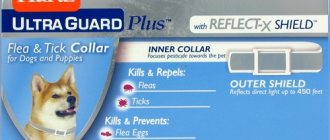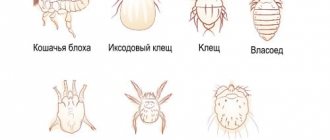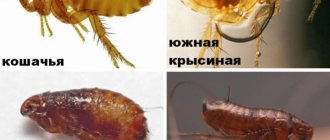Classification of parasites in dogs
Parasites are organisms that inhabit the body or inside the host and feed at its expense. A dog owner should know what parasites look like. This will help you quickly detect them and take the necessary measures.
Photos of parasites in dogs clearly reflect their appearance and size. Some of them pose a danger to humans because they are zoonotic, that is, pathologies caused by them, or they themselves can be transmitted from animals to humans. Dogs have external and internal parasites.
- External or skin parasites in dogs (ticks, fleas) live on the body of their owner. They can infect the animal with various diseases and cause the development of dermatological diseases. Fleas and ticks on a dog cannot be transmitted to humans, however, they can bite him and cause discomfort.
- Internal parasites (tapeworms, roundworms, hookworms), penetrating the body, are localized in different organs and tissues of the animal, causing disruption of the functionality of the organs, poisoning the body with the products of their vital activity.
Ear scabies in dogs and its treatment
Ear scabies in dogs occurs when parasitized by mites, which in appearance resemble subcutaneous scabies mites, but are larger and have longer limbs.
They are white in color and move slowly. They can be seen with the naked eye. Mites live deep in the canal that runs from the outer ear to the eardrum. Here they gnaw through the skin and feed on tissue fluid. The ear canal becomes clogged with mites and earwax, causing the dog to become extremely itchy. Trying to relieve it, she scratches her ear furiously and shakes her head. Sometimes the dog will keep its head tilted to one side, and if the infection is severe, it will run in circles or show other signs of nervousness.
To treat ear scabies in dogs, first of all, it is necessary to carefully remove the accumulated wax from the ears along with the mites stuck in it. To avoid accidentally injuring the dog, you need to tie it up or have someone hold it tightly.
The wax glands are supposed to protect the ear from infections and inflammation, so when you clean your ear regularly, they have to produce more wax. Sometimes the reason for increased secretion is related to individual characteristics, but even in these cases, the ears need to be cleaned every few months and very carefully, and best of all, by a veterinarian.
The cleaning procedure is as follows: make a swab from gauze and cotton wool and, dipping it in heated oil, wipe the inner surface of the ear. If the ear is very dirty, treat it with a 3% hydrogen peroxide solution.
To clean the ear canal, use a thin wooden stick wrapped in cotton wool, which is dipped in boric or salicylic alcohol. It is allowed to clean only the auricle, but under no circumstances go deep into the ear.
Why are parasites dangerous for dogs?
Experts say that most pets suffer from helminthiasis, that is, they are carriers of parasites, and at the same time they look healthy. You can protect your dog's health by being careful and following the veterinarian's instructions.
Lack of treatment may cause:
- Decreased immunity, cessation of development as a result of a deficiency of nutrients in the body.
- Irritability and nervousness due to constant discomfort, pain and itching.
- The development of serious and dangerous diseases against the background of infection and weakened immunity.
- Severe intoxication and allergic reaction as a result of the release of toxic metabolic products by parasitic organisms.
- Diseases of the brain, heart, liver, lungs and other organs.
Lack of treatment can lead to the development of epilepsy, intestinal obstruction, loss of vision and other serious complications, as well as cause the death of the dog.
Transmission routes
Basically, infection with worms occurs due to the ingestion of their eggs and larvae along with contaminated water, food or dirty soil. Parasites can enter the body through the skin if it is damaged. Heartworms can be transmitted by insect bites. A puppy can become infected from a mother who has helminthiasis.
A dog can become infected with skin parasites through contact with another animal. Fleas can enter your home through windows and doors. They can be brought into the house by a person on his shoes or clothes.
Fleas can become a carrier of tapeworms if a dog eats an animal infected with external parasites. A dog can pick up ticks while walking in nature.
A dog can become infected with parasites if:
- The pet owner does not comply with sanitary and hygienic standards;
- The dog does not undergo deworming to prevent the development of helminthiasis;
- Feeding rules are violated, the animal is fed raw meat, leftovers or low-quality food;
- The owner does not limit the dog’s contact with street animals;
- Individuals infected with worms live in the house with the dog.
Introduction
Parasitism is life at the expense of the host organism, which can be any animal or person. This is the most common way of existence of living beings in nature. Therefore, it is not surprising that parasites in dogs are a common cause of itching and skin diseases.
Some of them live only on animals and are transmitted through direct contact with sick dogs or cats, others live in the environment, and healthy dogs can become infected simply by walking in the forest or on the lawn near the house. In addition, a dog can become infected with parasites without even leaving the apartment through contact with outdoor shoes or through a mosquito bite.
Zoonotic parasites
Pet owners are interested in which dog parasites are transmitted to humans. A large number of helminth eggs accumulate at the anus.
By licking itself, the animal transfers them to other areas of the body. Close contact with a dog can lead to infection. Most often, tapeworms and roundworms migrate from dogs.
The tick is also dangerous for humans, as it easily spreads to the epidermis, clothing and bedding of a person upon contact. When petting your dog, you can become infected with scabies, ringworm and dermatophytosis (fungal infections).
How to deal with internal parasites (worms)
The most common internal parasites (worms) in dogs are roundworms - roundworms. Less commonly, tapeworms.
Roundworms.
Infection of dogs with roundworms occurs mainly during walks when interacting with dogs, especially with abandoned dogs that find food in garbage dumps.
When an animal infected with worms defecates, worm eggs come out along with the feces, and their larvae stick to the fur near the anus. When dogs “get to know each other,” they sniff each other and larvae from the sick animal end up on the nose and face of the healthy animal. The dog licks and swallows the larvae. This is how infection occurs.
Puppies are often infected with worms while still in the womb. Worm larvae can persist in the mother’s blood for a very long time, although the dog herself (the expectant mother) may practically not have worms. During pregnancy, the larvae become active and, through the bloodstream, undergoing a certain development process, enter the body of the puppies.
Thus, puppies may already be infected with worms. A person can also become infected with worm larvae from a dog, but then, when they enter the body, the larvae die. Roundworms are eliminated by using the drug “piperazine” or “pyrantel” in liquid form per 1 kg of dog weight - 0.5 ml of pyrantel. Fill a syringe (without a needle) and pour it into the dog’s mouth. After 40 minutes, feed the dog. The anthelmintic is given on an empty stomach.
After two weeks, the expulsion of worms is repeated. In order to protect babies from infection with worms, two weeks before estrus, if you decide to breed a dog, you need to check the expectant mother for worm eggs and, if there are any, expel them.
I would like to advise that if the test for worm eggs is negative, in any case, for prevention, give pyrantel once in the morning 40 minutes before meals.
A sign of worm disease in puppies and dogs is poor appetite, lackluster coat, and a large belly if thin. Sometimes, on the contrary, the dog eats a lot, but does not get better, sometimes vomiting white foam, as if poisoned. There is also “decaris”, which is not recommended for puppies. You need to consult a doctor.
Parasites in dogs
Symptoms of parasites in dogs
You can detect your pet's infestation with parasites at an early stage by regularly visiting the veterinary clinic and taking tests. Symptoms of infection in a dog can vary and depend on the type of parasite, the area of its localization and the degree of infection.
When infected with skin parasites, the dog actively scratches various surfaces and makes movements with its jaws. Your pet may experience redness of the skin, loss of fur, accumulation of black spots in the ears, nervousness, as well as fleas and flea droppings.
With helminthiasis in dogs the following are observed:
- Diarrhea, sometimes you can see blood and mucus in the feces;
- Vomiting;
- Loss of appetite and weight loss;
- Bloating, alternating constipation with diarrhea;
- Decreased activity, weakness, apathy;
- Skin rashes;
- Worm fragments or segments in feces;
- Respiratory dysfunction.
A change in your pet's behavior and the appearance of one of the symptoms listed above is a signal that the dog has health problems. It is necessary to urgently contact a specialist.
You cannot start treating an animal on your own, without consulting a veterinarian. The veterinarian selects a remedy for parasites for dogs only after diagnosing the disease and determining the type of parasite.
Symptoms
If the owner is attentive to his pet, he will definitely notice the symptoms of parasites in the dog. You can find out if she has helminths by the following signs:
- changes in the animal's behavior - it is restless, nervous; the dog often jumps up and inspects the tail;
- unkempt appearance: dull coat, constant moisture under the tail, flaky spots on the skin;
- unstable digestion: nausea, loose stools;
- the appearance of blood, mucus, parasites or their larvae in the animal’s feces;
- attempts to “ride” on the back of the body due to itching around the anus;
- bloating, especially in puppies;
- ribs may protrude;
- slower growth, general development, loss of appetite and, as a result, weight loss.
Quite often food preferences are distorted. A puppy or an adult dog tries to eat sand, stones, wood chips, that is, inedible objects. In such cases, it is necessary to use medications for dogs against parasites. Otherwise, helminthiasis can lead to intestinal obstruction and death of the animal.
Worms cause significant discomfort to animals
Types of parasites in dogs
Pet owners and breeders need to know what parasites can be found in dogs and how to deal with them once a diagnosis of helminthiasis is confirmed.
All types of worms are divided into three groups: Flat or cestodes, round or nematodes and flukes or trematodes.
Cestodes include:
- Cucumber tapeworm up to 65 cm long, living in the small intestine.
- Echinococcus and alveococcus. Parasites multiply in the small intestine, then penetrate the blood vessels, migrate to internal organs, most often to the lungs, kidneys, muscle tissue, brain, and liver.
Nematodes are:
- Hookworms up to 2 cm long, localized in the small intestine.
- Dioctophyma, living in the kidneys, in the abdominal cavity, in the ureter and bladder. This type of worm can be an intermediate host for filamentous worms localized in the bladder.
- Toxocara, the eggs of which are ingested along with food, feces and through contact with an infected animal. Through the walls of the small intestine they move into organs and tissues, forming a capsule around themselves and causing serious consequences.
- Trichocephalosis affecting the digestive tract.
- Heartworm is transmitted through insect bites. Once in the bloodstream, it migrates to the internal organs, where it continues to grow until the sexually mature phase.
- Thelyasia are localized in the conjunctival sac. Spread by fruit fly.
Trematodes have a flat shape with suckers (one or two). There are minimal sizes, the largest reach 2 cm. These include:
- Alaria, the larvae of which enter the dog's body when eating ferrets, mice or frogs. After entering the pet, parasites are localized in the lungs, mature and migrate to the intestines.
- Opisthorchia. They live in internal organs in the sexually mature phase. They enter the body when feeding an animal raw fish.
- Paragonims invade the respiratory organs and the brain. Infection occurs through a dog eating raw crayfish.
Types of Pet Parasites
Dogs' skin can harbor parasitic insects, mites, and even helminths. The most common parasitic insect found on the skin of dogs is fleas. These are small, mobile parasites up to 4 mm in size that can be seen with the naked eye. Although fleas live on dogs and cats, their eggs, larvae and pupae are found in the environment, such as dust or carpet. Fleas often cause allergic dermatitis, for the treatment of which one treatment of the animal may not be enough and additional treatment prescribed by a veterinarian is required.
Another insect parasite of dogs is the lice beetle, the causative agent of trichodectosis. The size of this parasite is about 2 mm, they live on dogs and are transmitted by contact from sick dogs. Trichodectes do not live long in the environment; the entire development cycle lasts about a month.
Other common parasites in dogs are subcutaneous mites, which can only be seen with a microscope. For example, scabies in dogs, or sarcoptic mange, is caused by the parasitic mite Sarcoptes scabei (var. canis). Their size is only 0.2 - 0.5 mm.
Another parasitic cause of itching in dogs is cheyletiosis, popularly referred to as “fermenting dandruff.” This disease is caused by the Cheyletiella mite. The size of the tick is small (only 0.2 – 0.4 mm), which makes it impossible to see it with the naked eye. This mite causes itching and severe flaking of the skin and, moving along the surface of the skin, dragging these scales, creates the impression of moving dandruff.
Ear scabies, or otodectosis, is caused by the microscopic ear mite Otodectes cynotis. This parasite is most often detected by microscopy of earwax in dogs with itchy ears. Dogs can become infected not only from sick animals, but also from hidden carriers who do not show signs of the disease, but can transmit otodectosis, sarcoptic mange or cheyletiosis. It is important to remember that skin parasites can also be transmitted through grooming items, and even fleas can carry eggs and parasitic mites.
The subcutaneous mite Demodex canis causes a severe skin disease - demodicosis in dogs, which is not contagious. This mite is normally present in small numbers in the skin of healthy dogs, without causing harm, however, when immunity is reduced, demodexes begin to actively multiply and cause skin lesions and hair loss.
With mild demodicosis, young dogs can recover without treatment. However, severe demodicosis with extensive lesions leads to a further worsening of the decreased immune response, and often to secondary bacterial infections. In such cases, the animal may even die from exhaustion and blood poisoning. Dogs with a generalized form, as well as adult and elderly dogs with demodicosis, require treatment.
Photo. Demodex canis mite, the causative agent of canine demodicosis, under a microscope
Photo. A puppy suffering from generalized demodicosis, before and after treatment
Can worms cause itching and skin lesions in dogs? Most dog owners think of heartworms as worms that live in the digestive system. It is obvious that these intestinal parasites can lead to weakening of the body, exhaustion, and increased allergic reactions. A number of helminths, such as the cucumber tapeworm Dipylidium caninum, can cause itching at the base of the tail.
In addition, there are helminths that develop directly in the skin. For example, larvae of pelodera strongyloides, a free-living nematode that lives in rotting organic substrates (such as wet sawdust or soil), can cause inflammation and itching of the skin in dogs and humans. These helminths are not visible to the naked eye; their small size, less than one millimeter, allows L3 stage larvae and females to penetrate the skin. Peloderosis most often develops in the summer, but when dogs are kept in enclosures on rotting sawdust or in stables, it can occur out of season.
Another dermatosis caused by helminths is cutaneous dirofilariasis. Infection of dogs with heartworms (Dirofilaria repens, much less commonly Dirofilaria immitis) occurs through the bite of a mosquito or mosquito in the hot months.
Since it is not possible to completely avoid mosquito bites, regular use of drugs that have a detrimental effect on microfilariae (heartworm larvae that enter the dog’s bloodstream) can protect your pet from this disease.
Diagnosis of parasites
Only a specialist can determine the type, stage and degree of infection. The doctor prescribes a stool test and, if necessary, a blood test, which helps determine the pet’s condition and the level of functional changes in the body.
If helminthiasis is suspected, affecting the heart, bladder, lungs and liver, an ultrasound or radiography is prescribed.
Treatment of parasites in dogs
The therapeutic course is aimed at destroying eggs and adult worms. The choice of drug, course and duration of treatment is determined by a specialist.
- Treatment of a dog after diagnosis and prescription of therapeutic treatment is also possible at home.
- In some cases, treatment is organized through surgery, when the dog is operated on, removing a section of infected tissue along with worms.
Medicines for parasites
In veterinary practice, anthelmintic drugs are used in the form of tablets, injection solutions, pastes or drops for external use.
- Effective tablet drugs include Drontal plus and Milbemax. The active component of the medications penetrates the membrane of the parasites into the central nervous system and kills them.
- Injection solutions are injected subcutaneously or into the muscle. Due to rapid entry into the bloodstream, they have an accelerated effect. Available in powder form (dissolved in saline solution). Used to treat large breed dogs and large-scale infections. An effective drug is Droncit.
- Pastes or suspensions, produced in 50-100 ml quantities, are used to treat small dogs and puppies against parasites. They are applied to the pet's cheek. Veterinarians prefer the drugs Drontal Junior and Prazicide.
Medicines in the form of drops are used to treat external parasites. The best are Lawyer and Inspector.
- The active component of the drugs is absorbed into the dog’s bloodstream, destroying parasites and preventing their further reproduction.
- The disadvantage of these funds is the cumulative effect in tissue structures, causing intoxication.
Preventive actions
Even pets living at home are susceptible to helminthiasis or infection with external parasites.
Regular preventive measures will help protect your beloved pet from dangerous diseases caused by parasites, as well as protect family members and especially children who come into contact with the dog.
Necessary:
- Feed your dog only thermally processed food.
- Do not allow your pet to come into contact with street animals. Free range can only be allowed within a fenced area.
- Carry out deworming three times a year, choosing drugs with the consent of the veterinarian, only after examining the animal.
- Rid your pet of external parasites that are carriers of helminthiasis.
- Periodically treat the place where the dog lives, as well as its objects: toys, clothes, combs.
Compliance with hygiene and nutrition standards, regular consultations with a specialist and timely deworming will help prevent helminthiasis and the development of secondary pathologies caused by it.
Dog fleas in dogs and their photos
Fleas in dogs not only poison the animal's life, but can also be carriers of worms. There are mainly four types of fleas that parasitize dogs: canine, cat, human and suction fleas. Human fleas can live on dogs, cats and pigs. Felines prefer cats, but if they are not nearby, they are content with dogs. The dog flea prefers dogs, but will not miss an opportunity to bite a person. Sucking fleas also live on birds and can bite humans.
Female fleas produce a large number of eggs, which fall on the ground, floor, and upholstery. After a few days, they hatch into worm-like larvae, which after two weeks or more (depending on temperature and humidity) reach maturity and spin cocoons around themselves the size of a grain of wheat.
From these cocoons, after another week or several months, fleas appear, which try, if possible, to crawl to a height of 30 cm from the ground, floor, etc. Here they wait for a passing dog or other warm-blooded animal to jump on it and settle in their new "dwelling".
Look at what fleas look like on dogs in the photo to be able to recognize parasites in a timely manner:
Sticky fleas, unlike the other three species, do not jump from place to place, but choose a permanent home. In dogs they are usually located on the ears, and often a dog's ears are lined with hundreds of these parasites.











